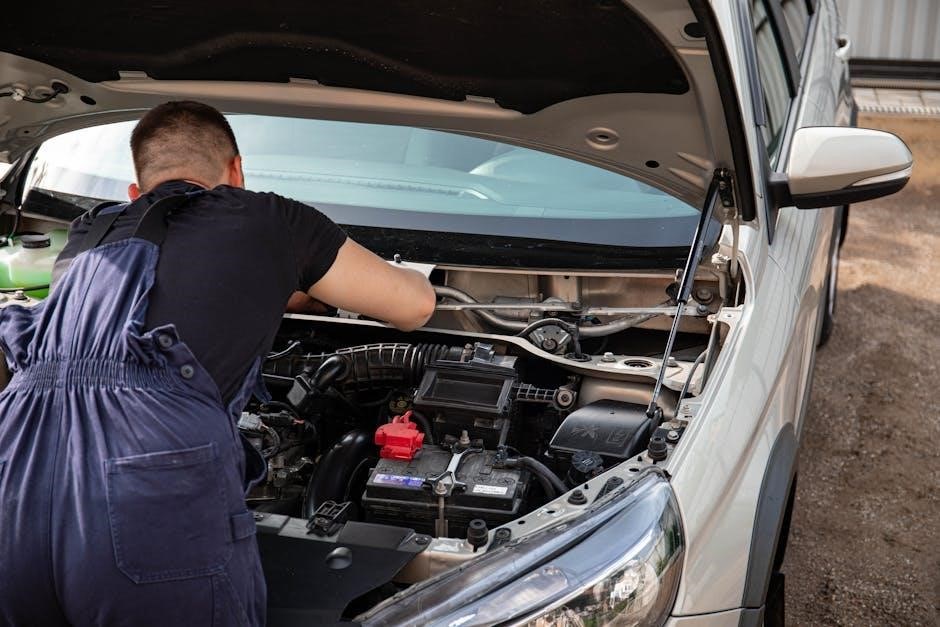Welcome to the Perkins 4-Cylinder Diesel Engine Manual, your comprehensive guide for understanding, maintaining, and operating this robust engine. Designed for operators, technicians, and enthusiasts, this manual provides essential information to ensure optimal performance and longevity of your engine.
1.1 Overview of Perkins Engines
Perkins engines are renowned for their reliability, efficiency, and durability, serving diverse industries worldwide. With a legacy spanning over 90 years, Perkins has established itself as a leader in diesel engine technology. Known for innovation, the company offers a wide range of engines, from compact units for small machinery to high-power solutions for industrial applications. Perkins engines are celebrated for their fuel efficiency, low emissions, and robust design, making them a preferred choice for both OEMs and end-users globally. Their commitment to excellence ensures superior performance across various operating conditions.
1.2 Importance of the Manual for Users
The Perkins 4-Cylinder Diesel Engine Manual is an indispensable resource for operators, technicians, and enthusiasts. It provides detailed instructions for maintenance, troubleshooting, and optimal operation, ensuring peak performance and longevity. By following the guidelines, users can prevent costly repairs, enhance fuel efficiency, and maintain safety standards. The manual also serves as a reference for diagnosing issues and understanding engine specifications, making it essential for anyone working with this engine. Adherence to the manual ensures compliance with manufacturer recommendations and supports warranty requirements.

Key Features of the Perkins 4-Cylinder Diesel Engine
The Perkins 4-cylinder diesel engine is renowned for its robust design, efficient fuel consumption, and exceptional reliability, making it a versatile choice for various industrial and automotive applications.
2.1 Engine Design and Architecture
The Perkins 4-cylinder diesel engine features a robust inline configuration, designed for durability and efficiency. Its cast-iron block and aluminum cylinder head provide strength and thermal efficiency. The overhead valve design ensures reliable operation, while the crankshaft and camshaft are precision-engineered for smooth power delivery. The engine incorporates a direct fuel injection system, enhancing combustion efficiency. A jacketed cooling system with a water pump maintains optimal temperatures. The exhaust manifold and turbocharger are integrated to improve performance and reduce emissions, making this engine a reliable choice for various applications.
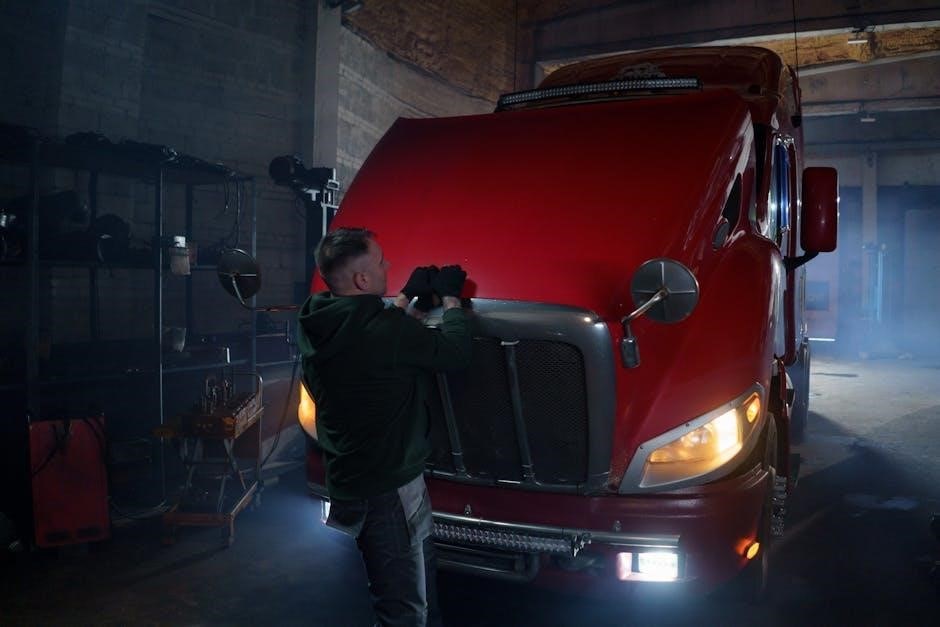
2.2 Fuel Efficiency and Performance
The Perkins 4-cylinder diesel engine is renowned for its exceptional fuel efficiency and robust performance. Equipped with advanced fuel injection systems, it ensures minimal fuel consumption while delivering high power output. The engine’s design optimizes combustion efficiency, resulting in lower emissions and smoother operation. With a strong torque curve, it excels in demanding applications, providing consistent performance across various operating conditions. This balance of efficiency and power makes it a reliable choice for industrial, agricultural, and construction sectors, ensuring reduced operational costs and enhanced productivity.
2.3 Reliability and Durability
The Perkins 4-Cylinder Diesel Engine is renowned for its exceptional reliability and durability, making it a trusted choice for demanding applications. Built with high-quality materials and robust design, the engine withstands rigorous operational conditions. Advanced manufacturing processes ensure consistent performance and longevity. Regular maintenance, as outlined in the manual, further enhances its lifespan. This engine is designed to deliver uninterrupted service, ensuring minimal downtime and maximum productivity across various industries.

Technical Specifications of the Perkins 4-Cylinder Diesel Engine
This section details the engine’s displacement, power range, torque output, and emissions compliance, providing a clear overview of its capabilities and operational parameters.
3.1 Displacement and Power Range
The Perkins 4-cylinder diesel engine offers a range of displacements, typically from 2.2 to 4.4 liters, delivering power outputs between 40 to 150 horsepower. These configurations ensure versatility across various applications, from industrial machinery to marine vessels. The engine’s power range is designed to meet diverse operational demands, providing reliable performance while maintaining fuel efficiency. Whether for heavy-duty tasks or lighter applications, the engine’s displacement and power options are tailored to optimize productivity and durability.
3.2 Torque and Speed Ratings
The Perkins 4-cylinder diesel engine delivers impressive torque and speed ratings, ensuring robust performance across various applications. Torque, measured in Nm, indicates the engine’s rotational force, while speed ratings, in RPM, define its operating range. These specifications are crucial for matching the engine to its intended use, whether for heavy-duty operations or high-speed applications. Proper understanding of torque and speed ratings helps optimize engine performance, fuel efficiency, and overall productivity, ensuring the engine operates within its designed limits for maximum reliability and longevity. Always refer to the manual for precise ratings tailored to your specific engine model.
3.3 Emissions Compliance and Standards
The Perkins 4-Cylinder Diesel Engine is designed to meet stringent global emissions standards, including Tier 4 and Euro 6 regulations. It incorporates advanced technologies such as exhaust gas recirculation (EGR) and diesel particulate filters (DPF) to minimize emissions. Compliance ensures reduced environmental impact while maintaining performance. Adherence to these standards is critical for regulatory approval and operational efficiency. Always refer to the manual for specific emissions-related maintenance and adjustments to ensure compliance and optimal engine function.
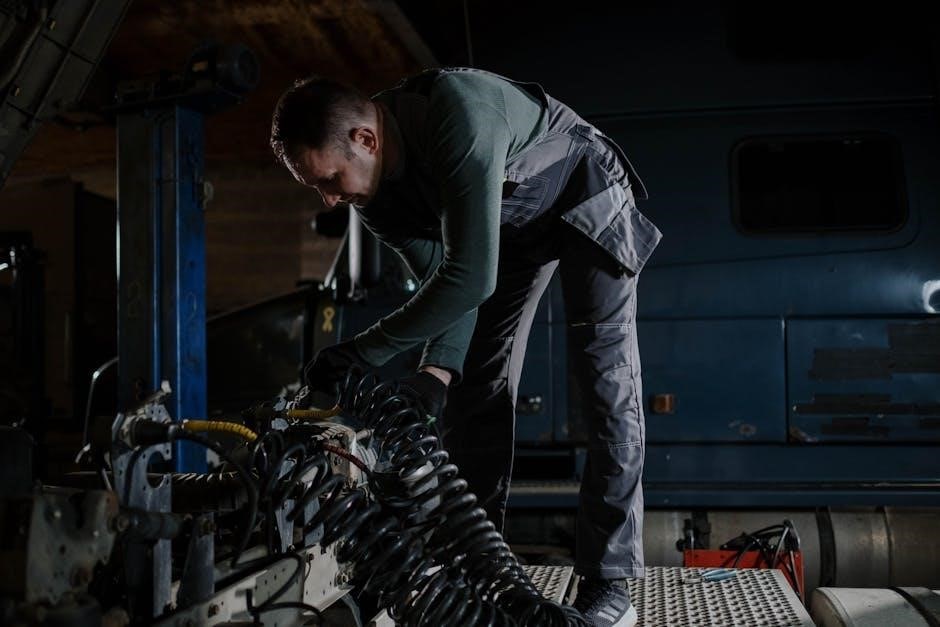
Maintenance and Service Guidelines
Regular maintenance is crucial for optimal engine performance. Follow guidelines for parts inspection, timely replacements, and overall servicing to ensure efficiency and longevity. Adhere to recommended schedules.
4.1 Routine Maintenance Schedule
A well-structured routine maintenance schedule is crucial for the Perkins 4-Cylinder Diesel Engine. Daily checks include inspecting oil levels, coolant, and fuel. Weekly, examine air and fuel filters, belts, and hoses. Monthly, perform battery tests and clean or replace filters as needed. Every 500 hours, change the oil and filters, and inspect the cooling system. Annual servicing includes overhauling the injection system and replacing critical wear parts. Adhering to this schedule ensures optimal performance, reduces breakdown risks, and extends engine lifespan.
4.2 Oil and Filter Replacement
Regular oil and filter replacement is crucial for maintaining the Perkins 4-Cylinder Diesel Engine’s performance and longevity. Always use the recommended oil grade specified in the manual. Replace the oil filter at every service interval to prevent contamination and ensure optimal engine lubrication. Dispose of used oil and filters responsibly, adhering to environmental regulations. Refer to the manual for specific instructions and recommended replacement intervals to maintain engine health and efficiency.
4.3 Cooling System Maintenance
Regular cooling system maintenance is crucial for preventing overheating and ensuring optimal engine performance. Check the coolant level regularly and top it up as needed using a 50/50 mixture of antifreeze and water. Inspect hoses and belts for cracks, leaks, or wear, and replace them if necessary. Clean the radiator core to ensure proper airflow and check for blockages. Test the coolant for pH levels and corrosion protection. Replace the coolant every 2 years or as recommended. Inspect the water pump for signs of wear and ensure it operates smoothly. Always refer to the manual for specific guidance.

Troubleshooting Common Issues
The Perkins manual aids in quickly identifying and resolving engine issues, minimizing downtime and ensuring smooth operation. It offers practical advice for diagnosing and resolving problems, empowering users to maintain peak performance confidently.
5.1 Identifying Fault Codes
Fault codes are critical for diagnosing issues in the Perkins 4-Cylinder Diesel Engine. These codes, typically alphanumeric, indicate specific malfunctions. The engine’s electronic control system generates codes, which can be retrieved using diagnostic tools. Understanding the code structure is essential for accurate troubleshooting. For example, “P” codes relate to powertrain issues, while “U” codes indicate network communication problems. Always use the Perkins Diagnostic Tool or consult the manual for precise code interpretations. Addressing fault codes promptly ensures optimal engine performance and prevents further damage.
5.2 Common Engine Problems and Solutions
The Perkins 4-Cylinder Diesel Engine may experience issues like low power output, excessive smoke, or overheating. For low power, check fuel flow and turbocharger performance. Excessive white or black smoke indicates faulty injectors or incorrect fuel. Overheating can result from coolant leaks or a blocked radiator. Address these by inspecting hoses, replacing faulty injectors, or cleaning the radiator. Regular maintenance, such as filter replacements and proper lubrication, helps prevent these issues; Always refer to the manual for specific solutions and safety guidelines.
5.3 Diagnostics and Repair Tools
Proper diagnostics and repair tools are essential for maintaining and fixing your Perkins 4-Cylinder Diesel Engine. Use electronic diagnostic software to identify fault codes and troubleshoot issues efficiently. Essential tools include multimeters, compression testers, and fuel pressure gauges to diagnose engine performance. Additionally, specialized tools like crankshaft locking kits and injector testers ensure accurate repairs. Always refer to the manual for recommended tools and procedures to avoid damage and ensure reliability. Regularly update your toolkit to align with the latest engine technologies and standards.
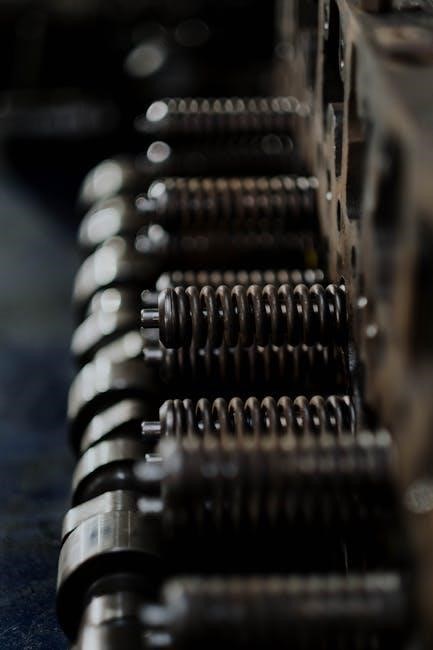
Operating Instructions for the Perkins 4-Cylinder Diesel Engine
Ensure safe and efficient operation by following the guidelines outlined in this manual. Understand engine controls, monitor performance, and adhere to safety protocols for optimal functionality and longevity.
6.1 Pre-Operation Checks
Before starting the Perkins 4-Cylinder Diesel Engine, perform a thorough pre-operation check. Inspect the engine oil and coolant levels, ensuring they are at recommended levels. Check hoses and belts for signs of wear or damage. Verify the fuel system for leaks or contamination and ensure the fuel tank is adequately filled. Test the functioning of critical systems, including the cooling, electrical, and starting systems. Review any fault codes using the diagnostic tools. Always consult the manual for specific procedures and safety guidelines to ensure a smooth and safe engine startup.
6.2 Starting and Stopping Procedures
To start the Perkins 4-Cylinder Diesel Engine, ensure all pre-operation checks are completed. Turn the key to the “start” position and allow the engine to idle for a few minutes to warm up. For stopping, reduce the engine load gradually and press the shutdown button. Avoid sudden stops, as this can cause damage. Always follow the recommended shutdown procedure to ensure proper cooling and prevent potential issues. Regularly reviewing these steps in the manual will help maintain smooth operation and engine longevity.
6.3 Load Management and Optimal Performance
Proper load management is crucial for maximizing the efficiency and lifespan of your Perkins 4-Cylinder Diesel Engine. Always monitor engine load to avoid overloading, which can lead to overheating or reduced performance. Adjust engine speed and torque according to the workload to ensure optimal fuel efficiency and minimize wear and tear. Gradually increase or decrease the load to avoid sudden strain on the engine. Regularly check the engine manual for specific load recommendations to maintain peak performance and extend service life.

Safety Precautions and Guidelines
Always wear personal protective equipment, including gloves and goggles, when handling engine components. Ensure proper ventilation when working with fuel and lubricants to avoid inhalation hazards.
7.1 Handling Fuel and Lubricants
Handling fuel and lubricants requires strict adherence to safety protocols to avoid accidents and contamination. Always store fuel and lubricants in approved containers, away from heat sources and open flames. Ensure the area is well-ventilated to prevent the accumulation of fumes. Use clean, lint-free cloths when wiping spills, and dispose of waste materials according to environmental regulations. Never mix different types of fuel or lubricants, as this can degrade their quality and harm the engine. Follow the manual’s guidelines for filling the fuel tank and changing oils to maintain engine health and performance.
7.2 Working with Electrical Systems
When working with the Perkins 4-Cylinder Diesel Engine’s electrical systems, ensure all safety precautions are followed. Always disconnect the battery before servicing to prevent accidental starts. Use multimeters and wiring diagrams to identify faults. Avoid short circuits, as they can damage components. Ground yourself properly to prevent static discharge. Regularly inspect wires, connectors, and fuses for wear or corrosion. Never bypass safety circuits, as this can lead to serious malfunctions or hazards. Always refer to the manual for specific procedures and guidelines.
7.3 Personal Protective Equipment
Personal Protective Equipment (PPE) is vital for ensuring safety while working with the Perkins 4-Cylinder Diesel Engine. Always wear safety glasses to protect against debris, gloves to prevent cuts and abrasions, and steel-toe boots for foot protection. High-visibility clothing is also recommended to enhance visibility in low-light conditions. Failure to use PPE can result in serious injuries, including eye damage or chemical burns. Always follow the manual’s guidelines for PPE to maintain a safe working environment and comply with industry standards;

Environmental Considerations
Perkins engines are designed with environmental responsibility in mind. This section highlights strategies for minimizing emissions, managing waste, and optimizing energy efficiency to reduce ecological impact.
8.1 Emissions Reduction Strategies
The Perkins 4-cylinder diesel engine incorporates advanced emissions reduction technologies to meet global environmental standards. Key strategies include optimized combustion systems, exhaust after-treatment devices like DOC and DPF, and selective catalytic reduction (SCR) for minimizing NOx emissions. Regular maintenance, proper fuel quality, and adherence to service intervals ensure compliance with emissions regulations. Additionally, using ultra-low sulfur diesel and maintaining correct engine calibration further reduces environmental impact, promoting sustainable and eco-friendly operation.
8.2 Proper Disposal of Waste Materials
Proper disposal of waste materials from your Perkins 4-Cylinder Diesel Engine is crucial for environmental protection. Always adhere to local and international regulations when handling hazardous waste, such as used oil, filters, and coolant. Ensure all materials are drained and stored in approved containers before disposal. Use authorized waste management facilities to prevent contamination of soil and water. Never dispose of hazardous waste in landfills or waterways. Consult local authorities or environmental agencies for guidance on compliant disposal practices.
- Drain fluids responsibly.
- Segregate recyclable and non-recyclable materials.
- Avoid illegal dumping to protect ecosystems.
8.3 Energy Efficiency and Best Practices
Maximizing energy efficiency is crucial for optimal performance and environmental sustainability. Regularly maintaining the engine, ensuring proper fuel injection settings, and monitoring combustion efficiency can significantly reduce fuel consumption. Operating the engine at its designed load range minimizes energy waste. Avoiding prolonged idling and using genuine parts ensures consistent performance. Implementing a preventive maintenance schedule further enhances efficiency. By following these best practices, users can achieve lower emissions, reduced operating costs, and prolonged engine life while adhering to environmental standards.
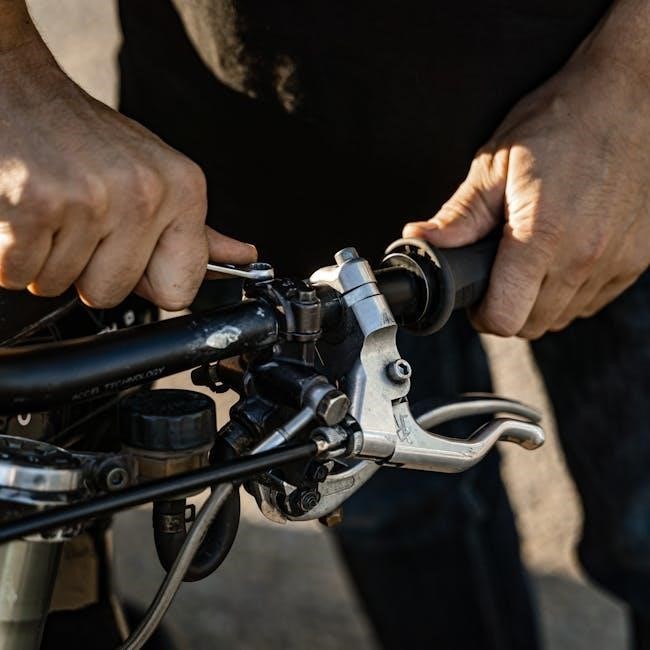
Warranty and Support Information
This section outlines the warranty terms, support services, and contact details for Perkins engines. It also explains how to access genuine parts and troubleshooting assistance effectively.
9.1 Understanding the Warranty Terms
The Perkins 4-Cylinder Diesel Engine Manual includes detailed warranty information to protect your investment. The warranty covers parts and labor for defects in materials and workmanship under normal use. Coverage duration varies by model and usage, typically spanning several years or operating hours. Proper registration and adherence to maintenance schedules are required to maintain warranty validity. Understanding these terms ensures you can address issues promptly and minimize downtime. Always refer to the manual for specific conditions and exclusions.
9.2 Contacting Perkins Support
For any inquiries, technical assistance, or parts-related questions, Perkins provides dedicated support services. You can contact their team via phone, email, or through the official website. Perkins support operates globally, offering assistance in multiple languages. Their experts are available 24/7 to address issues promptly. Ensure to have your engine serial number ready for quicker service. Visit the Perkins website for regional contact details and live chat options. Always rely on genuine Perkins support for reliable and accurate solutions.
9.3 Genuine Parts and Accessories
Using genuine Perkins parts and accessories ensures optimal performance, reliability, and longevity of your 4-cylinder diesel engine. These components are specifically designed to meet precise specifications and undergo rigorous testing for quality assurance. Always source parts from authorized dealers to maintain warranty validity and prevent potential damage from non-original replacements. Genuine accessories, such as filters and belts, are engineered to complement engine operation seamlessly. Prioritize authenticity to uphold your engine’s efficiency and durability over time.
10.1 Summary of Key Points
This manual provides a detailed guide to the Perkins 4-Cylinder Diesel Engine, covering its design, operation, maintenance, and troubleshooting. It emphasizes the importance of proper maintenance routines, such as oil changes and cooling system checks, to ensure longevity. The manual also highlights fuel efficiency, emissions compliance, and safety precautions. Troubleshooting sections help identify and resolve common issues, while environmental considerations promote sustainable practices. By following the guidelines, users can optimize engine performance, reduce downtime, and maintain compliance with environmental standards. Adhering to the manual ensures safe and efficient engine operation.
10.2 Final Tips for Engine Longevity
To maximize the lifespan of your Perkins 4-Cylinder Diesel Engine, adhere to the recommended maintenance schedule, use genuine parts, and monitor performance regularly. Always store the engine in a dry, cool environment when not in use and ensure proper fuel quality. Avoid extreme temperatures and overload conditions. Regularly inspect belts, hoses, and connections for wear. By following these guidelines and staying proactive, you can ensure your engine delivers reliable performance for years to come.
